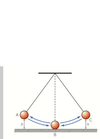ch11 Flashcards
(61 cards)
conditions for simple harmonic motion
force is directly proportional to displacement, and the acceleration (force) acts in the opposite direction to the displacement this tells us force is always directed to the position of equilibrium
examples of simple harmonic oscillators
springs and pendulums
what is the time for one complete swing of an oscillator
time period
what is the amplitude of an oscillation
greatest displacement from the equilibrium position
what is simple harmonic motion
an oscillation in which the restoring force on an object (acceleration of the object) is directly proportional to it’s displacement from the centre, and is directed towards the centre
equation for angular frequency, w, rate of rotation
w = 2πf rad s^-1
versions of equation for displacement applying angular velocity disp = max at t = 0 disp = 0 at t = 0
if displacement is at max when t = 0 use the equation x = Acos(2πft) -> x = Acos(wt) if displacement is 0 when t = 0 x = Asin(2πft) -> x = Asin(wt) x = displacement in metres A = amplitude t = time in seconds
how to calculate acceleration using angular velocity and the differentiation model for disp to accel
a = -w²x = -4π²f²x = d²x / dt²
what does a negative value mean when you calculate displacement of an object using the displacement equation x = Acos(2πft)
the mass is below the equilibrium at that point in instant
what is the acceleration at the point in equilibrium and why is this
acceleration at the point of equilibrium is 0, as x = 0 and a ∝ -x
a simple harmonic oscillator has an amplitude of 0.02m, the frequency of the oscillation is 1.5Hz calculate the maximum acceleration
maximum acceleration is at max displacement as a ∝ -x so x is 0.02 a = -4 * π² * f² * 0.02 = -1.8 ms^-2
displacement, x, against time graph for SH oscillator max disp at t = 0 T = 2π what type of graph is it
when amplitude A is max (max displacement) at t = 0, it’s a cosine graph

velocity, v, against time graph for SH oscillator max disp at t = 0 T = 2π what type of graph is it
the graph of velocity is the gradient of the displacement graph at t = 0, disp graph has max displacement so velocity starts at 0 the graph of velocity is a reflection of sin x in the x-axis (-sinx)

acceleration, a, against time graph for Sh oscillator max disp at t = 0 T = 2π what type of graph is it
the graph of acceleration is the gradient of the velocity graph at t = 0, displacement graph has max displacement so velocity is 0 and as velocity is 0, acceleration starts at minimum value the graph of acceleration is a reflection of cos x in the x-axis (-cosx) the graph of acceleration is also the opposite of the displacement graph

displacement, x, against time graph for SH oscillator min displacement at t = 0 T = 2π what type of graph is it
at t = 0, displacement is 0 (0 amplitude A) it’s a normal sin x graph

velocity, v, against time graph for SH oscillator min displacement at t = 0 T = 2π what type of graph is it
the graph of velocity is the gradient of the displacement graph at t = 0, disp graph has 0 displacement so velocity starts at max value it’s a cosine graph

acceleration, a, against time graph for SH oscillator min displacement at t = 0 T = 2π what type of graph is it
the graph of acceleration is the gradient of the velocity graph at t = 0, displacement graph has 0 displacement so velocity is at max acceleration graph is the opposite of the displacement graph, but as displacement is 0, acceleration starts at 0 a = -x acceleration is a reflection of the displacement graph

value of velocity when displacement is maximum
0
value of velocity when displacement is 0
maximum
value of displacement when velocity is 0
maximum
value of displacement when velocity is maximum
0
what equation can be used to calculate acceleration, and thus velocity and displacement, from iterative models and calculations
F = ma
maximum value of acceleration graph
w²A
maximum value of velocity graph
wA





